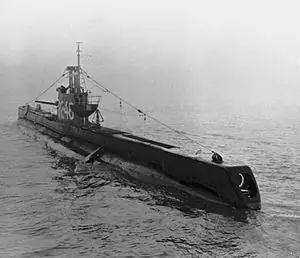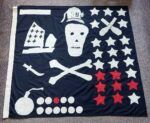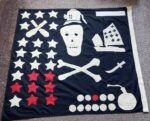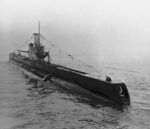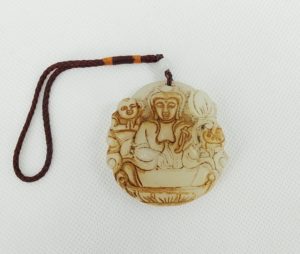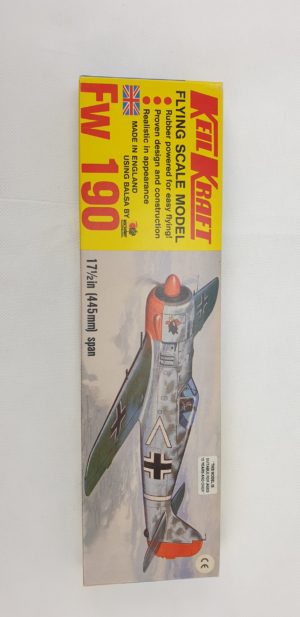~ Royal Navy HMS Statesman Submarine P246 WWII Jolly Roger Flag ~
One of the most decorated Royal Navy submarine Jolly Roger flags known to exist.
HMS Statesman was an S-class submarine of the Royal Navy. She was laid down on 2 November 1942 and launched on 14 September 1943 by Cammell Laird. P246 was the only naval vessel to bear the name Statesman. For sale is the original Jolly Roger (or officially, attack) flag which she would have flown. She spent the time between August 1944 and August 1945 with the Eastern Fleet, where she had an eventful career as is attested by the number of operational symbols. She sank the Japanese army cargo ship Sugi Maru No. 5 (the former Panamanian-flagged, Norwegian-owned Gran), twenty-five Japanese sailing vessels, the Japanese trawler Matsujima Maru No. 3, four Japanese coasters, including Nippon Maru No. 19, Nanyo Maru No. 17, and Nippon Maru No. 14, a small Japanese tanker, five small unidentified Japanese vessels, ten small Japanese landing craft, three Japanese barges, and a derelict wreck drifting in the Straits of Malacca, described as probably a coaster.
~ Symbols & Meanings ~
1. Stars (sometimes surrounding crossed cannon) Deck gun was used to sink a target: white stars for merchant ships, red stars for warships
2. Circles – Sea mine Minelaying operations. Red indicates a warship sunk, white a merchant one
3. Diver’s helmet – Exceeded safe diving depth
4. Dagger ‘Cloak and dagger’ operation: typically the delivery or recovery of shore parties from enemy territory
5. White bar Merchant ship sunk
6. The sampan vessel – small coastal vessels sunk by gunfire, one per star
7. Mortar bomb – ship sunk by demolition charge
~ Sinking of Haguro ~
On 9 May 1945, the Japanese heavy cruiser Haguro and the Japanese destroyer Kamikaze left Singapore for a transport run to the Andaman Islands. They were sighted the next day in the Malacca Strait by Statesman and her sister, HMS Subtle. To intercept the Japanese ships, a task force made up of two battleships, one heavy cruiser, two light cruisers, four escort carriers, and eight destroyers left Trincomalee. Aircraft from the escort carriers attacked the Nicobar Islands on 11 May, forcing Haguro and Kamikaze to head back to Singapore.
On 14 May, the Japanese ships again departed Singapore for the Andaman Islands. They were spotted the next day northeast of Sabang by aircraft from the British escort carrier HMS Shah. A few hours later, they were attacked by aircraft from the British escort carrier HMS Emperor, causing light damage to Haguro. In the meantime, Japanese aircraft had sighted Allied destroyers closing in on Haguro, and once again the Japanese ships reversed course.
In anticipation of the Japanese reversal of course, the commander of the British 26th Destroyer Flotilla, Captain M.L. Power, on board HMS Saumarez, along with the other British destroyers HMS Venus, HMS Verulam, HMS Vigilant, and HMS Virago, plotted a course to intercept the Japanese ships, which they did shortly before midnight on 15 May. After careful maneuvering, the destroyers began attacking the Japanese ships from all sides shortly after one o’clock the following day. Haguro was hit by torpedoes and gunfire and sank around 0230 hours, but not before it hit Saumarez with gunfire. The escorting Japanese destroyer Kamikaze escaped with only minor damage. It was during this operation that HMS Statesman put into Pangkor Laut, a small island in the Malacca Strait, to retrieve Lt Col. Spencer Chapman, a British Army officer who had been operating behind Japanese lines since the invasion in 1942.
~ Dimensions ~
The flag is 47cm in length and 43.5cm in width.
~ Condition ~
The flag is in very good condition for its age and use. With little brown markings along the top white edge where it would have been flown from the submarine, which gives this incredible item more of a story. The seams are in excellent condition. Please review the photographs as they form part of our condition report.














